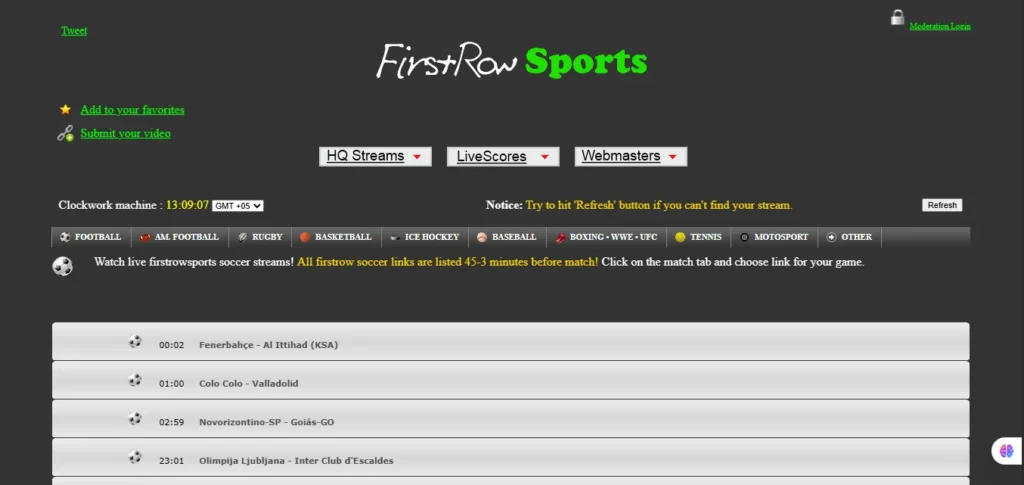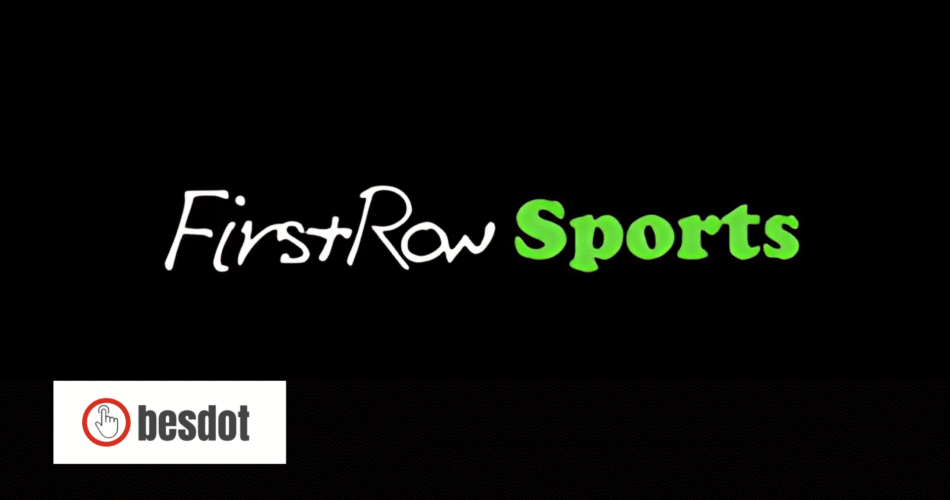
- Introduction: Historical Roots of FirstRow Sports
- How It Worked: Flash-Based Aggregation
- Core Appeal vs. Critical Flaws
- Legal and Safety Challenges
- Post‑Flash Decline and Technological Breakdown
- Modern Alternatives and Industry Changes
- Future Outlook: What Comes Next?
- Conclusion: Real Talk on FirstRow Sports
- Related Guides:
Introduction: Historical Roots of FirstRow Sports
FirstRow Sports launched in the early 2000s, offering fans free access to live sports like football, boxing, and basketball. This Flash-powered streaming hub catered to those seeking cost-free alternatives to cable or regional subscriptions. Embracing the era’s technology and culture, it delivered aggregated links that prioritized broad, if unregulated, access to sporting events.
Its model reflected a larger shift in digital consumption that fans demanded immediate, inclusive access. FirstRow played an influential role in reshaping expectations: fans grew to expect coverage of global sports events on any device, anytime. Despite its grey legal standing, FirstRow’s simplicity and scope effectively democratized sports viewing and shaped future streaming norms.
How It Worked: Flash-Based Aggregation
FirstRow operated as a streaming aggregator, listing upcoming fixtures and multiple external links per match. These links led to third-party hosts using Adobe Flash Player, allowing real-time broadcasts without FirstRow storing any video files. Users simply clicked a link and viewed streams almost instantly.
Adobe had planned the end-of-life (EOL) for Flash as early as 2017. It officially ended support on December 31, 2020, and blocked Flash content entirely from running after January 12, 2021. This was done to address security vulnerabilities and encourage modern HTML5 standards.
With Flash gone, FirstRow’s infrastructure collapsed. Few mirror sites adapted via Flash emulators, and most streaming capabilities ceased to function, marking the downfall of the once-popular platform.
Core Appeal vs. Critical Flaws
Appeal
- Free access to sports content—ideal during the rise of cord-cutting.
- Wide coverage across multiple sports and countries.
- Redundancy with multiple links per event for backup.
- Simple interface for easy browsing without user registration.
Flaws
- Inconsistent quality: Lagging, buffering, and low resolution were common.
- Security concerns: Flash player vulnerabilities exposed users to malware and ransomware.
- Legal gray area: While it didn’t host content, FirstRow was still held liable. The UK High Court ordered ISPs to block the site for violating broadcasting rights.
- Unstable domain: Frequent shutdowns and mirror site migrations confused users.
Despite its popularity, FirstRow’s benefits came with significant compromises in reliability, safety, and legality.
Legal and Safety Challenges
Sports rights holders like the English Premier League have taken aggressive legal action to protect broadcasting rights. In 2013, the UK High Court compelled major ISPs to block FirstRow Sports, citing unauthorized retransmission of live games. This set a precedent for global enforcement of intellectual property laws against aggregators.
From a cybersecurity perspective, many unauthorized streaming platforms have been flagged for spreading malware, spyware, and phishing threats. Unlike verified platforms, these sites lack encryption, user protections, and standardized content delivery mechanisms.
A peer-reviewed study also found that illegal streaming sites aggressively collect user data, sometimes more intrusively than legitimate services. This includes third-party trackers, browser fingerprinting, and forced redirects, all of which compromise user privacy.
Post‑Flash Decline and Technological Breakdown
After Flash was discontinued, FirstRow’s core delivery system vanished. Adobe blocked content playback at the browser level, and Microsoft removed Flash from Windows systems entirely. Few sites transitioned to secure technologies like HTML5, which now powers all major video platforms, including YouTube and Netflix.
Most mirror sites failed to evolve, continuing to push outdated or nonfunctional streams. Some adopted experimental Flash emulators such as Ruffle, but these tools aren’t designed for live streaming and offer minimal success with multimedia playback.
The lack of innovation, combined with heightened legal pressures and user mistrust, led to FirstRow’s widespread decline.
Modern Alternatives and Industry Changes
Today’s sports streaming environment has matured. While some illegal services persist, most users now prefer stable, licensed platforms that offer security, HD quality, and official support.
| Service | Coverage | Cost (Monthly) | Legality |
|---|---|---|---|
| ESPN+ | UFC, MLS, NCAA, global soccer | $10.99 | Yes |
| DAZN | Boxing, MMA, football | $29.99+ | Yes |
| FuboTV | NFL, NBA, MLB, NHL | $74.99+ | Yes |
These platforms offer not only high-quality streams but also features like DVR, multi-device access, parental controls, and encryption. Their rise signals a major shift in consumer behavior toward legal, reliable, and ethical consumption.
Future Outlook: What Comes Next?
Unauthorized streaming still exists but faces significant challenges:
- Tighter regulations: Authorities like the European Union Intellectual Property Office (EUIPO) and U.S. Copyright Office have expanded crackdowns on piracy and stream theft.
- Tech progression: Modern frameworks such as WebRTC and HLS dominate live video delivery today, offering real-time latency with secure media transport.
- Growing user awareness: The average internet user is increasingly aware of the risks of free streaming platforms and more willing to pay for quality and security.
- Open-source future? Platforms like Ruffle or peer-to-peer content delivery tools may offer innovation, but without licenses, they remain niche.
As media rights and technologies evolve, the window for unlicensed aggregators like FirstRow continues to shrink.
Conclusion: Real Talk on FirstRow Sports
FirstRow Sports once revolutionized how fans accessed live sports. But its reliance on Flash, disregard for copyright, and insecure practices made it unsustainable. When Flash ended, so did FirstRow’s relevance.
Today’s users demand more secure, high-resolution, reliable access backed by law and supported by modern technology. Platforms like ESPN+, DAZN, and FuboTV fulfill that promise. The future belongs to services that combine accessibility with accountability.
FirstRow’s story is a reminder: disruptive tech needs a foundation of legality and adaptability to survive. Free is tempting, but it’s not always the best deal.

